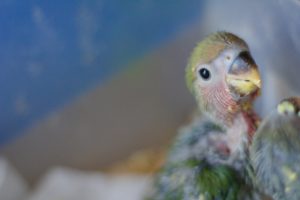
When children grow, naturally their linguistic skills improve as they learn. They learn by the sounds they hear around them. They especially learn by repeating what their parents say as well as that of the influential people around them. It should not come as a strong surprise that all the vocalizing animals of the world might do the same thing as we know human toddlers do–babble in imitation of what they see and hear around them. In a recent scientific study, a team discovered that parrot chicks babble in the nest while they learn the calls and vocalizations that surround them and are important for them to know.
The team of scientists involved in this study was stationed in Venezuela at the Masagural Biological Station. Using the station’s long-run study involving around 10,000 green-rumped parrotlets, they had a ready-made stage for their interest. The birds were already using nesting cavities specially designed to help the parrots create private nesting areas. The new science team used audio-visual installations within the cavities to listen to and watch the birds. It was determined that the male and female chicks quietly “babbled” while alone in a seeming attempt to produce meaningful language. The study also mentions that babbling among songbirds occurs only in males, while this group of babblers occurred in both sexes.
Practice Calls
The team also discovered that the parrotlet chicks in the study group began to babble incessantly after about 20 days after hatching. They slowly reduced babbling afterward as they began to learn the useable language and sounds of their parents and using those learned language parts more. Eventually, the chicks learned proper alarm sounds as well as the proper vocalizations for food requests, and the many other distinct sounds that signify something of importance.
The most important part of this study, while it helps us to understand more about how parrots and other birds learn and develop their shared language, is how it closely mimics that of the human child in learning language and its use. This is important for other ongoing studies in the human child as they learn to speak properly, selecting words and sounds that deliver a satisfying or otherwise productive response. It’s found that stress hormones are produced by the child’s endocrine system around the time they begin to babble. These attempts to communicate with their surroundings and their parents are essential to survival. They are a request for the things necessary for survival in what likely feels like a threatening world.
The team studying the parrotlets supplied the birds with a minute amount of a stress hormone (corticosterone) and found that the birds increased their babble. Chicks that did not receive the hormone babbled significantly less. The conclusion was that measured introduction of stress hormones at an earlier age than typical babbling begins has a strong effect on brain development in a parrotlet chick. Other, more direct kinds of study areas are undertaken within the scope of this study to help determine further development of the brain.
There’s much we still do not know of child development in every species, whether that be human or animal, or even insects. But as we begin to isolate the behavior of every living creature into practical and archived knowledge, we consistently learn how to improve on effective development as we grow. This important study is but one area. Science is working to expand that further.
You can read the abstract from that study at the Proceedings of The Royal Society B Biological Sciences website.
